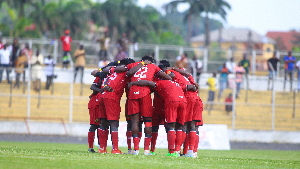Since 2005, Ghana continues to show steady improvements in economic growth of over 7% per year on average, making it the first African country to meet the Millennium Development Goal (MDG) 1 of eradicating extreme poverty and hunger.
However, as growth has accelerated the disparities between the Northern and Southern broad regions, in terms of economic development, becomes clearer. To tackle poverty in Northern Ghana, the country relies heavily on inclusive agricultural growth in the rural areas which contribute to equitable and sustainable poverty reduction and food security in the country.
That was the objective of the Northern Rural Growth Programme (NRGP), jointly funded by the African Development Fund (ADF) the concessional arm of the African Development Bank (AfDB), the International Fund Agricultural Development (IFAD), and the Government of Ghana.
The Programme is being funded by AfDB to the tune of US$ 61.29 million while IFAD and the Government of Ghana are contributing US$ 22.73 million and US$ 10.37 million, respectively.
The NRGP aims to substantially increase the income of rural households in Northern Ghana. The project covers 57 districts from the Northern Region, Upper East Region, Upper West Region and adjoining districts of the Brong-Ahafo Region. The project has four components: (I) Commodity Chain Development; (II) Rural Infrastructure Development; (III) Access to Financial Services; and (IV) Programme Coordination.
Financing small-scale Irrigation, breaking poverty in Northern Ghana
Infrastructure development, including small-scale irrigation, was a main component of the NRGP. With respect to small scale irrigation, the program also targeted some districts in the southern part of the country. These were added during the mid-term review of the project. The objective was to finance the completion of some schemes earlier funded by AfDB. Examples include: Inland Valley Rice Development Project (IVRDP) and Small Scale Irrigation Development Project (SSIDP). All the schemes targeted were then satisfactorily completed and put to use by the beneficiaries.
The NRGP constructed and rehabilitated 650 ha (about 102% of the set target of IVRDP schemes with an initial target of 633 ha, reaching 4,787 farmers.
The program has also developed 1,264 ha of SSIDP irrigation out of 2,191 ha (about 58% of the set target; 1,003 ha of flood recession schemes reaching 8,264 of beneficiaries, and exceeding the initial target of 1,000 ha. Also the plan to put 150 ha under river pump was fully achieved. It is important to note that all completed schemes are under cultivation and mainly used for the cultivation of rice, tomato, onions, green pepper and cabbage.
Important testimonies
Soloman Addae (fondly called King Solomon), a 70-year old farmer is one of the beneficiaries of the Aframso Inland Valley Rice Scheme rehabilitated in the Ashanti Region. He said “I am 70 years old but I still have the strength to farm”. Like other farmers, King Solomon does not own the land; he “offers” half a bag of the harvested rice to the land owner who gave him about 1 ha of land.
Solomon expressed gratitude for the facility given by the project: “Before NRGP intervention, I could only get two bags per harvest; now (after the development of the irrigation scheme) I am able to get 15 bags of rice per harvest.” The scheme improved the productivity of the farmers in Ashanti and consequently increased their incomes. “I can sell one bag of rice at 200 Ghana Cedis in the market, out of which I pay 20 Cedis/bag for threshing (taking out stones from rice) of the rice to add value to my produce before going to market, one (1) Cedis for transportation and half of a Cedi (50 Pesewas) as market toll. ”
Farming is not only attractive to the old farmers; it is also remunerative to the youth. According to Emmanuel Antwi (24 years old with a Bachelor of Science Degree in Management from University of Education, Kumasi Campus).
Cap on his head, Emmanuel stood up and said: “I am very happy with NRGP’s intervention, with the irrigation scheme developed by the project I can get more profit and reimburse the credit I buy fertilizer for yield improvement. I am also able to harvest 32 bags of rice per season (instead of only 10 bags before NRGP), and harvest three times per year because of the availability of water”. He added, “before the construction of the scheme, there were only 10 farmers in the fields; but now we are 100 farmers, I encourage young people to come and work to earn money and improve their lives.” Very ambitious, Emmanuel intends to return to school and earn a Master’s degree in Agriculture, he believes that Agriculture is the future and wants to make it his business.
Small scale irrigation has increased the yield of rice to a maximum of 7.5 t/ha and a greater involvement of youth and women in the utilization of the developed fields.
Warehouses are key to marketable produce
Badu town in the Tain district of the Brong-Ahafo Region was among the communities which benefitted from the NRGP intervention. “NRGP did a lot for this region: established DVCC, trained farmers, built two feeder roads, linked the farmers to market and constructed a warehouse for them” said David Asamoah , chairperson of the DVCC.
Overall, the programme constructed 600 km of feeder roads, 200 km of farm tracks, 10 warehouses and 4 pack houses. Farmers in the Region expressed gratitude for the facilities provided by the programme. Among others, they noted that the benefits of the construction of warehouse included improved productivity and increased household income. “After harvesting, and in the dry season, we were worried about our produce, we provided individual security because people stole our produce” said one of the farmers. We used to store our produce in a general park, our maize lost its value because of the conditions of storage, the reason for which we sold it lower than market price.”
With a capacity of 1000 MT, the warehouse in Tain, was the first to be completed by the programme to store mainly grains and cereals (maize and rice). “The warehouse built by NRGP helped us to increase our incomes, because now we have an option, we can decide when to sell, to whom and at what price. The warehouse provided us with a winnower for cleaning the grains and cereals before storage. This adds value to our produce before selling; the World Food Program is one of our client’ one of the beneficiaries said.
The management of the warehouse also created employment for about five (5) young people, and generates some revenue for its maintenance: “200 farmers are storing their produce in the warehouse, each of them have 20 bags stored in the warehouse, they paid one (1) Ghana Cedis/ bag per month“ said the chairperson. This helped farmers reduce post-harvest losses and led to an improvement of productivity and income. This encouraged them to get more involved by paying the necessary fees to maintain the warehouse. A very optimistic, Asamoah intends to buy a motorcycle to use for sensitization of farmers in others communities to come and store their produce in the warehouse.
Despite the programme’ s achievement e in terms of development of rural infrastructure, NRGP fell short of constructing some designed infrastructure due to different challenges faced at the beginning of the project. The designs have now been passed on to the Ghana Agricultural Sector Investment Programme (GASIP) one of the project’s managed by IFAD for completion.
NRGP can be considered as a showcase of fruitful partnership between the AfDB and IFAD. It is also expected that the programme will be a source of inspiration and replication in other regions.
Business News of Thursday, 6 July 2017
Source: classfmonline.com

















